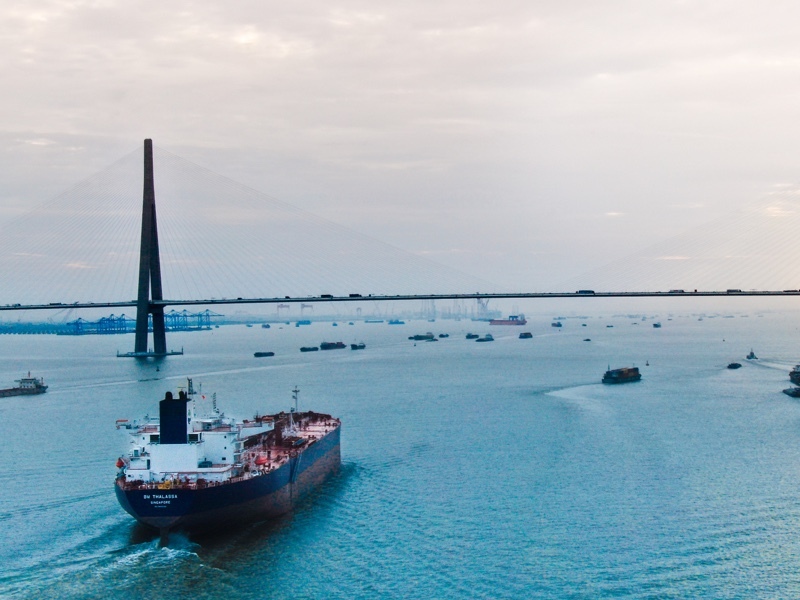07 | Sustainability agenda
Environmental actions, measures and progress
In pursuit of our vision to be ‘Best on Water’, Hafnia is committed to adapting to the constantly changing conditions while continuing to deliver energy to sustain the world.
Hafnia has implemented clear and effective measures that solidify our firm commitments to provide safe, sustainable and efficient hydrocarbon transportation solutions and to participate in global efforts combatting climate change.
Besides working to reduce our emissions to air and sea, Hafnia also strives to meet our social obligations for sustainable development. By providing hydrocarbon transportation solutions, Hafnia is contributing and helping people to meet basic standards of living across the globe. Hydrocarbons run our planes, trains and automobiles. They power our homes and are used to make the roads that connect our cities. From clothes to cleaning products, packaging and pharmaceuticals – our world is currently run on hydrocarbons. Affordable energy facilitates better living conditions for many around the world, especially when we can deliver it in a safe and responsible fashion.
As a leading shipping company, Hafnia sees social and environmental benefit as responsibilities. We take all of these responsibilities seriously, and are doing all we can to deliver cargoes with the lowest possible footprint.


Hafnia is contributing towards the shipping industry’s efforts to reduce environmental impact. As a member of the Getting to Zero Coalition, Hafnia is committed to challenging the industry of today to deliver the industry of tomorrow.
This is done via:
- Collaboration with shipyards, charterers, bunker suppliers, and regulatory bodies
- Decarbonisation – towards full compliance with IMO 2030 requirements
- Vessel optimisation initiatives
- Implementation of a clear sustainability strategy
The above focus areas are described in further detail in the following pages.
emission in grams per ton nautical mile (Based on capacity work)gms/T NM5.835.70
| Unit | 2019 | 2020 | |
| Fleet Emissions and Efficiency Metrics | |||
| Number of vessels included in emission computation for the year | 89 | 89 | |
| Fuel use and resulting emissions | |||
| HSHFO | Metric ton | 383,202 | 20,451 |
| VLSFO | Metric ton | 24,066 | 362,816 |
| LSMGO | Metric ton | 81,128 | 86,652 |
| CO2 | Metric ton | 1,529,223 | 1,484,724 |
| NOx | Metric ton | 79,586 | 77,724 |
| SOx | Metric ton | 21,095 | 4,906 |
| Distance sailed in nautical mile | NM | 4,594,384 | 4,549,692 |
| CO2 emission in grams per ton nautical mile (Based on capacity work) |
gms/T NM | 5.83 | 5.70 |
Please note: For SOx calculation (S%), average 2.7% S for HFO, 0.5% S for LSHFO & 0.1% S for MGO is used. For NOx calculation, 14.4 g/kwh is used. Kwh is computed from Specific energy. HFO: 40,400 MJ/Kg, LSHFO: 41,200 MJ/Kg, MGO: 42,200 MJ/Kg was used.
Constant collaboration with stakeholders to ensure sustainable progression
In order to ensure we are on the right track in a fast-moving world, we make it a point to engage with all of our stakeholders continually. Regular dialogue with employees, crew, customers, investors, bank partners, industry groups, governments, regulators, suppliers and third-party providers through formal and informal channels is essential to the way Hafnia develops its approach to sustainability.
Through systematic, consistent and intentional communication with its stakeholders, Hafnia keeps its stakeholders updated and assured of its commitments and actions for sustainability. This is because we believe our stakeholders are essential partners in safekeeping our natural environment. For example, meaningful decarbonisation will require us to work in concert with shipyards, charterers, bunker suppliers, and regulatory bodies.
Therefore, be it through one-on-one meetings, board meetings, conferences and press releases, social media or media coverage, we openly share and discuss with our stakeholders our business performance and sustainability approach.